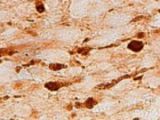A recent study in the journal Acta Neuropathologica Communications details the discovery of damaged and swollen nerve fibers in the brains of Iraq and Afghanistan combat veterans who, while engaged in one battle or another, were exposed to one or more blasts.
The researchers behind this investigation say that the broken nerve fibers they documented in the brains of combat veterans form a honeycomb pattern that looks nothing like the brain damage car crashes, sports injuries or drug overdoses can cause.
What's more, the Johns Hopkins University School of Medicine scientists go on to detail that the damaged and swollen nervous tissue observed in the brains of Iraq and Afghanistan veterans is found not just in one area, but all throughout the brain, critical regions included.
Documenting signs of brain injury in combat veterans
As part of their investigation, the John Hopkins University School of Medicine researchers looked at the brains of 5 deceased US veterans known to have been exposed to blasts from explosive devices when in the army. They also studied the brains of 24 other people who were never in the military.
In the case of 4 of the combat veterans whose brains they had the chance to study, the scientists found sings of inflammation and nerve fiber damage arranged in a rather strange honeycomb pattern. Such lesions were present in several brain regions, including the ones that control memory and reasoning.
This is yet to be confirmed, but the researchers suspect that these distinctive lesions that they only found in the brains of veterans formed either at the time of a blast that caused nerve fibers to break, or some time later, when fibers weakened by a blast eventually gave out.
The honeycomb pattern might be the signature of shell shock
Ever since World War I, it's been known that, having returned home from the battlefield, many former soldiers have trouble getting back to business as usual. In a nutshell, combat veterans are likely to experience psychological and social problems when leaving the military.
For decades, this phenomenon remained poorly understood. In fact, some combat veterans were told to get over themselves and settle into their usual routine already. As it turns out, chances are that there was one very good reason these combat veterans were behaving rather strange.
According to Vassilis Koliatsos with the Johns Hopkins University School of Medicine, it is very possible that broken and swollen nerves like the ones documented by him and his colleagues in the brains of Iraq and Afghanistan veterans explain the odd behavior of some former soldiers.
More precisely, the researchers say that this very specific type of brain damage, most likely caused by blasts from explosive devices, is a signature of shell shock and is probably to blame for symptoms such as depression, post-traumatic stress, anxiety and even substance abuse.
“We identified a pattern of tiny wounds, or lesions, that we think may be the signature of blast injury. The location and extent of these lesions may help explain why some veterans who survive IED attacks have problems putting their lives back together,” said Vassilis Koliatsos.
“When you look at a brain, you are looking at the life history of an individual, who may have a history of blasts, fighting, substance abuse or all of those,” the Johns Hopkins University School of Medicine researcher went on to explain, as cited by Science Daily.
If it is indeed true that shell shock leaves its mark on the brain and that the behavioral issues displayed by combat veterans have a neurological basis, the find could make it easier for specialists to help former soldiers return to their usual lives when leaving the army.

 14 DAY TRIAL //
14 DAY TRIAL // 

